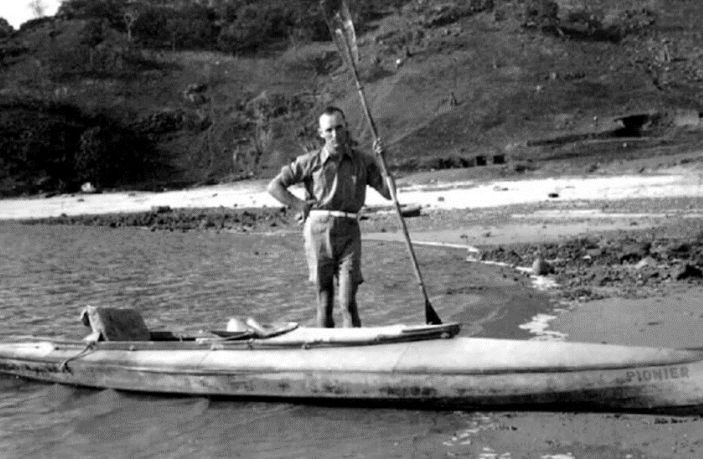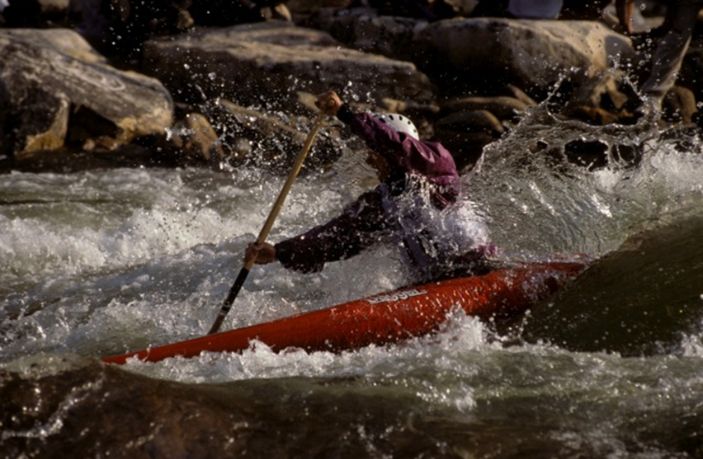Whitewater kayaking, an exhilarating water sport that combines adventure, skill, and adrenaline, has a rich and captivating history that dates back millennia. From its humble origins as a mode of transportation to its evolution into a beloved recreational activity, the history of whitewater kayaking is a testament to the enduring human spirit of exploration and our innate connection to nature’s wildest waters. Join us on a paddle through time, as we dive into the captivating history of whitewater kayaking.
We’ll be discussing:
- The Origins: A Means of Transportation
- The Advent of Recreational Kayaking
- Growth and Development
- The Rise of Freestyle Kayaking
- Exploration and Extreme Challenges
- Whitewater Kayaking in the Modern Era
The Origins: A Means of Transportation

Image Credit: https://www.thecanadianencyclopedia.ca/en/article/kayak
Whitewater Kayaking’s roots can be traced back to indigenous cultures around the world that relied on river systems and the ocean for transportation and hunting. The Inuit people of what is now known as Canada’s Arctic, for example, used kayaks made from animal skins stretched over wooden frames to navigate treacherous waters for hunting and fishing seal. These early kayaks showcased the first inklings of what would later become the art of navigating rapids and whitewater.
The Advent of Recreational Kayaking

Image Credit: https://www.wiredforadventure.com/oskar-speck/
It was in the early 20th century that whitewater kayaking began to emerge as a recreational activity. In the 1920s, passionate paddlers in Europe, particularly in Germany and Switzerland, began exploring rivers for pure enjoyment. The rivers of the European Alps presented an enticing playground for kayakers, and the sport started gaining popularity among those seeking adventure and a connection with the natural world.
Growth and Development

Image Credit: https://paddlerezine.com/an-interview-with-richard-fox/
Whitewater kayaking experienced significant growth and development in the mid-20th century. The formation of kayaking clubs and organizations, along with advancements in kayak design and equipment, helped propel the sport forward. Pioneering kayakers such as Olli Grau, Richard Fox, and Horst Fursattel pushed the boundaries of what was possible on the river, tackling increasingly challenging rapids and waterfalls.
The Rise of Freestyle Kayaking

Image Credit: https://kayakjournal.wordpress.com/2013/09/06/paddler-focus-kent-ford/
In the 1970s and 80s, freestyle kayaking emerged as a distinct discipline within the sport. Kayakers sought to master the art of performing acrobatic maneuvers and tricks on river features such as waves and holes. The new dimension added a creative and expressive element to whitewater kayaking, captivating both participants and spectators alike.
Exploration and Extreme Challenges

Image Credit: https://www.aquaglide.com/common-waters-past-and-current-legends-in-the-whitewater-kayak-industry/
As the sport continued to grow in popularity, a new breed of kayaker emerged – those who sought out uncharted rivers and extreme challenges. Exploratory kayaking expeditions took paddlers to remote corners of the globe, where they tackled raging torrents and cascading waterfalls previously untouched by humans. These daring adventurers pushed the limits of what was considered possible in whitewater kayaking, continually redefining the boundaries of the sport. Some of the top athletes in the world are Dane Jackson, Nouria Newman, Bren Orton, Adrian Mattern, Emily Jackson, Aniol Serraolses, and Rush Sturges.
Whitewater Kayaking in the Modern Era

Today, whitewater kayaking has established itself as a mainstream adventure sport enjoyed by enthusiasts worldwide. Whitewater kayaking is the perfect sport for folks seeking both extreme adventure as well as leisure and peaceful connections with Nature and Rivers. Kayaking can include aspects of extreme adventure travel, athletic prowess, intense teamwork, but it does not need to be the adrenaline-focused sport it is sometimes made out to be. Technological advancements have led to the creation of lightweight and highly maneuverable kayaks, enhancing the experience for paddlers of all levels.
Major competitions and events, such as the Whitewater Grand Prix and the Freestyle Kayaking World Championships, showcase the incredible skill and artistry of the sport’s top athletes on challenging whitewater. While the Madawaska River is a perfect river for developing kayak skills no matter the reason for doing the sport, and no matter the level of intensity your are interested in. There is a sheer joy that comes with floating on water, flowing with it’s currents.
Whitewater kayaking and canoeing schools have increased in number and popularity, which has provided easier access to the sport for beginners. The first whitewater school in the world, Madawaska Kanu Centre (located in Barry’s Bay, ON), was founded in 1972 by Hermann and Christa Kerkhoff after they won the 1968 Canadian Slalom Championships. The family business has been passed on to its third generation and proudly introduces hundreds of people to the beauty of whitewater kayaking and canoeing through their courses every year.
In Conclusion…
The history of whitewater kayaking paints a clear picture of the human spirit’s need for exploration, adventure, and connection with nature. From its humble origins as a means of transportation to its evolution into a thrilling recreational activity, the sport has captivated and inspired countless individuals over the years and created a worldwide community. It’s an honour to be a part of such a tight-knit, resourceful, and understanding network. See you on the river!










